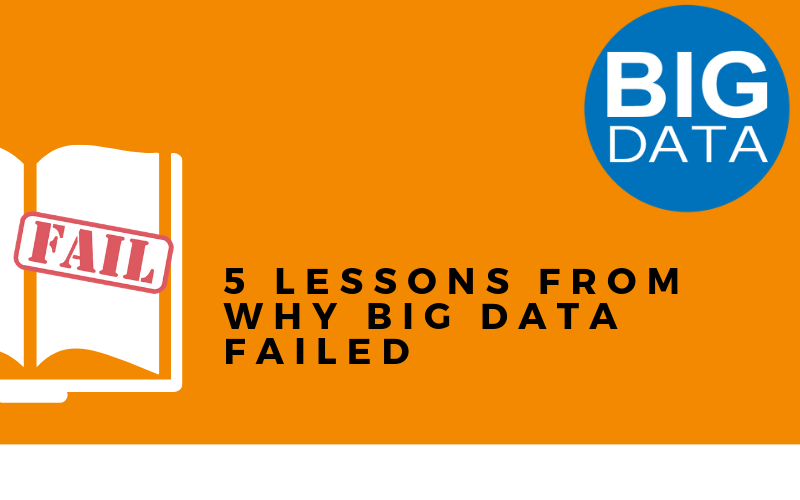
5 Lessons from Why Big Data Failed
Three years ago we were all predicting that Big Data will be the next Big Thing. Then came the fall: it was a trend that seemed to generate some rather embarrassing headlines. While many corporations spent millions on working with data deluge, many kept grappling with exactly how to use it. What benefits could they cull? Three years down the line, there are people talking about the demise of Big Data. Some big names were involved in embarrassing Big Data flops and suddenly everyone deemed it the big tech hoopla.
Table of Content
Time for stock taking
But, this would be foolish. Perhaps, it was over hyped, its importance and even functionality overstated. But data cannot be wrong. It can only be USED wrongly. The reality of Big Data implementation may not have lived up to the hype, but it still has its benefits. In fact, instead of writing an obituary, it’s time to take stock, to understand what we could have done different and see if we can find good use for it.
Ultimately, data is sacrosanct. We can argue about methodology and even its functionality. But by itself, data is pure. So, our trouble has always been about making it work. We have to make it tech-friendly — easy to analyze, integrate and work with. We also have to see its business-worthiness. Ultimately, a business will only use what it finds profitable, no matter what the larger lesson.
So, it’s time to understand where we went wrong. Perhaps, this is just a course correction, one that every new idea needs. With the right implementation, Big Data can still give us big dividends. For all those embarrassing stories that hit the frenzied news cycle, the truth is that there are thousands of other businesses that are using data to better their work.
So, here are 5 lessons we can learn from why Big Data failed to work for some:
1. Deal with data integration challenges
One of the biggest challenges of working with data is to take out what you want from the deluge that flows in. This includes mundane stuff like texts, receipts, GPS data, shop floor video and many other bits and pieces that flow into any business. The challenge often lies in how to separate the goods from the waste. We need proper software to make sense of the unstructured data and to use the right analytical tools.
Sears failed to do this with this when they devised their MDM strategy. The strategy was ineffective and failed to integrate across different suppliers, customers and products. There was noticeable confusion that ultimately, led to poor customer services.
But analytics, when used properly can completely change picture. The Commonwealth Bank of Australia, like many other banks, uses analytics to assess risks and any problems in the cash flow. This is a smoothly integrated process that is designed to ring the alarm bells the moment something goes wrong.
2. Understanding that not all data is the same
Algorithms deal with data impersonally. They are designed to look for patterns and trends. The problem with this is that though it’s mostly accurate, human beings are rarely that predictable. Algorithms, no matter how smart they are, cannot always anticipate the way people behave. The fact is that data is not always the same. The meaning of a phrase or a keyword can change and give up results that are totally redundant.
The biggest example is the well known disaster that was Google Flu. Created in 2009, it was meant to predict flu outbreaks in 25 countries. Its error margin was a whopping 140%! This is because the algorithm failed to assess that every time someone searched on ‘fever’ or ‘cold’ it did not equal a fever!
3. Checking your data
Yes, the process of working with Big Data has to be automated, but you do need human intervention and check at some point. You cannot take the data blindly, run analytical tools and then just automate your production line. You do have to check to see if it makes sense or aligns with your objectives.
Amazon paid the price of automatically putting on sale T-shirts with messages like ‘Keep Calm and Punch Her” without checking these. The company blamed poor analytics. Nevertheless it was an unnecessary and careless mistake.
4. We need both speed and scale
Any Big Data analytics software that cannot deal with a large scale data is pretty much useless in most cases. To be effective, it must sift through a deluge of data quickly. The relevancy of the information is often dependent on how fast we get it because it effects how we implement it.
Most success stories of Big Data are centered around the speed with which we were able to extract the information and use it in real time. This is especially relevant in retail where buyer preferences can be studied and if predicted, implemented immediately. For instance, Macy’s Inc used SAS institute tech to adjust pricing of a whopping 73 million items in (almost) real time! Tipp24 AG, a betting platform used KXEN software to develop a predicative model that worked on the fly.
5. Keep it realistic
The problem with hype is that it always falls flat when confronted with reality and in the process, trashes something that is actually valuable. This is the case with Big Data. We expected a super smart all encompassing system which would predict everything for us. Apart form the creep factor, it’s actually pretty stupid because human beings are never that predictable. So, our final lesson is to look for simple and realistic goals. The truth is that these are the solutions that we need.
Currently, the concept of big data is universal and to a great extent associated with huge associations or firms who have colossal of data environments. Subsequently, it has come to understand that there are some common risks that Big Data would probably experience. It’s the ideal time for a Big Data reality check. Big data is a considerable deal and it overwhelms the business on everyday basis. Big Data Solutions Companies provides tremendous chances to advance and transform the manner your business runs. With a large range of companies plunging into their data to analyze the financial risk, limit customer churn, and improve user experience, the likelihood of failure also raise. Failure can, and does, occur if we don’t play safe and make every attempt to keep the project on track.


